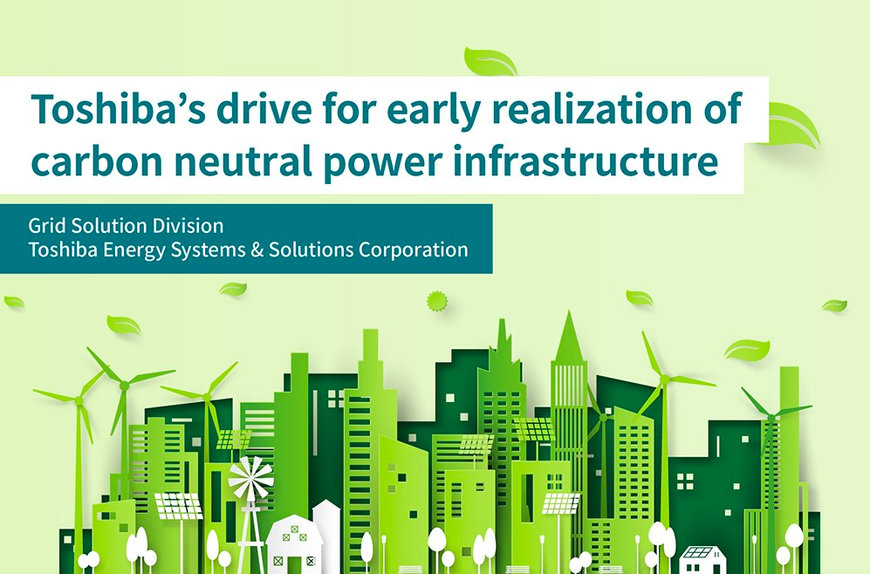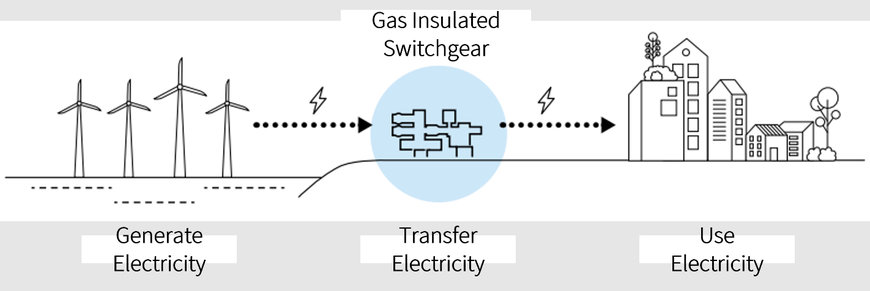smartbuildingmag.com
20
'23
Written on Modified on
Toshiba News
TOSHIBA WORKS TOWARD SUSTAINABLE ELECTRIC POWER INFRASTRUCTURE
One way forward is to replace SF₆ with natural-origin gases, but the feasibility of this has long been questioned. In this two-part article, we look at attempts to develop a new eco-friendly GIS that meets this challenge and assures stable operation of power transmission infrastructure.

Climate change is strongly driven by increases in greenhouse gases in the atmosphere that are warming the planet. CO₂ is familiar to all of us, but there are others, including sulfur hexafluoride, SF₆, which is almost 25,000 times more potent at trapping heat than CO₂. SF₆ is used in gas-insulated switchgear (GIS), an essential part of electric power infrastructure, and there is now a worldwide race to develop and switch to a different alternative gas.
GIS is an essential part of electric power transmission infrastructure
GIS basically acts as a switch to turn electricity flows on and off. It is installed in power transmission substations in the electricity transmission and distribution network, the power grid. It takes advantage of the high electrical insulating performance of SF₆ gas (gas insulation) to immediately cut the power in the event of a sudden voltage surge or an abnormal power flow triggered by a lightning strike and so forth. The GIS safely disconnects the substation from the power grid, protecting stable supply and the power infrastructure.

The role of GIS in power distribution
A GIS houses circuit breakers, disconnectors, surge arresters, and other equipment in a metal tank filled with SF₆ gas. SF₆ has excellent insulating properties and unmatched strength in switching large power flows on and off. It is also a chemically stable, non-toxic and odorless gas, and easy to handle, other than for the need for careful control to prevent its release into the atmosphere. SF₆ has a very long atmospheric life of 3,200 years, and once it is released into the atmosphere, its heat retention effect has a cumulative effect on warming.
Toshiba commercialized Japan’s first GIS in 1969, and used SF₆ to do so. Since then, many electric power companies have relied on Toshiba-made GIS to ensure stable power supply, and the company is the leader in Japan’s electric power market. Toshiba also offers compact SF₆ GIS that can be installed in underground substations in buildings and commercial facilities, delivering behind-the-scenes support for stable energy supply in urban centers.
Zero greenhouse effect! Japan’s first GIS for electric power using natural origin gases
On July 12, 2022, Toshiba announced the development of a 72/84 kV GIS that uses natural origin gases, and the receipt of its first order, from TEPCO Power Grid, Inc. The GIS replaces conventional SF₆ with dry air, a mixture of nitrogen and oxygen that is safer and that does not contribute to global warming itself.
For over 15 years, Toshiyuki Uchii of Toshiba Energy Systems researched the question of how to replace SF₆—starting at a time when interest in global warming was nowhere near as high as it is today. The unveiling of the new GIS was the moment when his years of work finally came to fruition. It also marked an important opportunity for Toshiba to show the world that it was possible to replace SF₆ with natural origin gases—and a new step toward carbon neutrality for electric power transmission and distribution infrastructure.
Toward development of GIS using alternatives to SF₆
In 1997, the United Nations Framework Convention on Climate Change adopted the Kyoto Protocol, which required both emerging economies and the developed economies to cut greenhouse gas emissions. SF₆ was one of the restricted gases designated as a target for reduction, and this triggered efforts around the world to cut its emissions.
Japan adopted the Closed Cycle Concept, a focus on minimizing leaks of SF₆ of power equipment while still making use of its special characteristics. As a result, SF₆ has been strictly managed, and properly collected and recycled. Emissions declined significantly in the 2000s, and by 2005 the industry had achieved its voluntary reduction target, along with its goals of preventing any leaks SF₆ into the atmosphere during GIS production and operation, and proper disposal of the gas when recycling became difficult.
Staying ahead of time and tackling difficult problems head-on
While developments of GIS was still based on SF₆ gas, Uchii promoted research on alternative gases in his laboratory. He was the first to point out that natural origin gases, such as nitrogen, oxygen and carbon dioxide, are the only suitable alternatives to SF₆ for electric power applications, in respect of toxicity, boiling point, stability, and environmental compatibility.
The electrical insulating capability of natural origin gases is only about a third of that of SF₆, so a large volume of gas is necessary to secure a comparable performance. On top of that, SF₆ also delivers excellent current interruption, and achieving the same level of performance with a GIS loaded with natural origin gases is another major issue. The cumulative result is unavoidable: larger GIS and higher costs. These conflicts ended up with a situation where consideration of alternative gases for GIS stayed at the research level.
In the mid-2010s, however, the tide turned dramatically. In Europe and the United States, moves to regulate use of SF₆ in electric power equipment gained momentum. Both in Japan and overseas, there was a change in perspective on using alternative gases, and there was a shift toward putting Uchii’s research to practical use.
It can be said that Toshiba has been able to stay ahead in technological development because it has continued to carry out research from a long-term perspective. In part two of this article, we will look at the development process for the new SF₆-free GIS, now put to practical use thanks to the hard work of a team of Toshiba engineers.
www.toshiba.com

